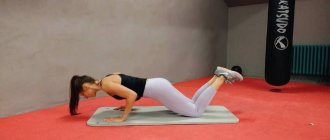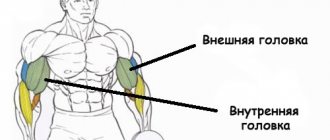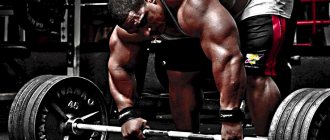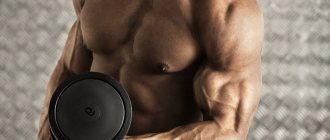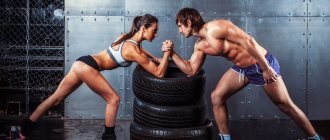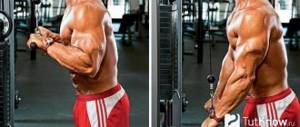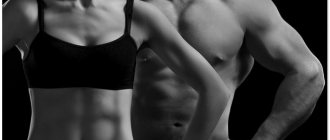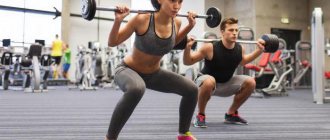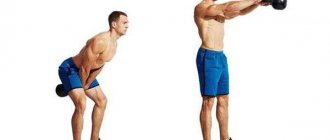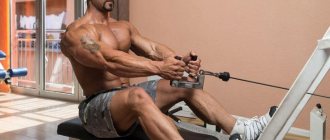Moon reflection
The myth of “tendon” strength.
Reading various sources about sports and martial arts, one constantly comes across stories about “tendon strength”, about methods of “strengthening” tendons, “stretching” tendons and secret methods of strengthening tendons. Let's try to understand the origin of this myth, the mechanisms of its stability and what lies behind it. These are just amateur notes; for a more serious study of the topic, you need to turn to thick manuals.
We can speak with confidence about two sources. Below we present them first without critical analysis.
The first (let’s call it “Western”) is the works of Alexander Ivanovich Zass (1888-1962), who was also known under the stage name “Iron Samson”. Since childhood, he had impressive strength and already at the age of 20 he performed in the Orenburg circus as a strongman. It is believed that he developed his own system of isometric training, which, according to him, primarily strengthened the tendons. Quote from his 1924 booklet “Samson's Systems and Methods, Explanations and Instructions”: “I am strong in sinew. FIRST, I WAS AIMED AT DEVELOPING THE MAIN CONNECTIVE TISSUE, RATHER THAN SUPERFICIAL MUSCLES. I DEVELOPED TENDON STRENGTH. Tendons are like cables between bones and muscles. Big biceps are the same indicator of strength as a big belly is an indicator of good digestion. This tendon pulls on the biceps, which contracts. THIS METHOD WAS USED ALL OVER THE BODY. Some men with thin legs are stronger than some with thick legs. Why? Because the power is in the tendons. Those invisible tough tendons that are second in strength and density after bones. Tendons are strong fibrous connections between muscles and bones. THEY ARE THE MAIN KEY TO STRENGTH AND OVERCOMING GREAT RESISTANCE. Without tendons one would not have any control over the body. There would be no rigidity, no stability of physical movement. They and their development are the secret of my strength. I am strong in sinew. Muscles alone will not hold horses back. But the tendons will be there - and they do it. But they must be grown. Oh yeah. They must be developed. There is a way to increase their strength, and this way, without false modesty, I have perfected. My method is real and effective."
The second source (“eastern”) is the training systems imported from China known as the “Canon of Tendon Modification” (易筋經), as well as the constant opposition of muscle force li (力) to the force jin (勁), which is born in the jin tendons (this homonym to the effort just mentioned, but written with a completely different hieroglyph 筋).
Unfortunately, this is a set of dogmatic misconceptions. First, let's understand the basic anatomy and physiology of the muscle. A muscle consists functionally (and morphologically) of two parts: muscle (in diagrams it is drawn in meat color), which in turn consists of contractile cells - myocytes, which respond to nerve impulses by contraction, and tendon (usually white in diagrams), consisting mainly from connective tissue (compact parallel bundles of collagen fibers). The function of the muscle part is to develop force, the function of the tendon is to transfer this force to the bone in order to move it or stabilize it (make it motionless, regardless of other forces applied to it). The tendon is a very strong structure - anyone who has bought meat not in pieces, but, say, a leg of lamb, is familiar with this and tried to cut the tendons. The tendon practically does not tear (although there may be so-called fatigue ruptures), and most cases of tendon rupture are when they are torn from the bone, or rather torn with a piece of bone, since the tendon penetrates deep into the bone with its fibers. The tendon is practically inextensible - try stretching it on the leg of a lamb or rabbit. If it were stretchable, it would cause us a lot of inconvenience. We strain the muscle, but the force from it is not transferred to the bone (the tendon is stretched), that is, the muscle is swollen, but there is no movement. Maybe this is necessary for some (participants in competitions of all kinds), but Nature (or God) did not create man for competitions, but for an active life as a very well-oiled mechanism. When doing stretching exercises, it is not the tendons that are stretched! And the muscles and ligaments! Relatively speaking, if the entire stretch is taken as 100%, then the contribution of the tendon is 1-3%, and the muscles and ligaments make up the remaining 97%. A few words about ligaments (they are often illiterately confused with tendons). These are also dense connective tissue cords, but they are not a continuation of the muscles, but spread from bone to bone, stabilizing the joint while allowing it to move (they, as mentioned above, are significantly more elastic than a tendon).
So! The tendon and the muscle part are all muscle. I repeat - a tendon is a part of a muscle that transmits the force developed by the muscle belly to the bone (or to the skin, in the case of facial muscles). The tendon is practically inextensible and cannot contribute to strength in any way! There is nothing in it to contract; its function is to direct force to the bone. Talking about tendon strength is complete ignorance!
But here the reader will have objections. After all, there are people who do not have huge lumps of muscles, but can develop very great strength, sometimes on the verge of magic. By the way, he had well-developed visible muscles. These comments can be answered in two ways. Firstly, muscle strength and its volume are not directly related. Using different training methods, you can develop muscle hypertrophy (its volume), even on the verge of swelling, working for an external observer, or you can develop muscle efficiency when a unit of its volume develops a significantly greater force than the same unit of hypertrophied muscle. And secondly! Until now, we have talked about one muscle, but when performing any action, we use almost all muscles to one degree or another, including both muscles that help the action (agonists and synergists) and those that “interfere” (antagonists). The development of the final effort will depend on the effectiveness of the inclusion of these muscles in action. We also need to take into account that for many movements in the body we build long muscle chains. For more information on this, see three sources: Myers T. “Anatomical trains and myofascial meridians”; Buske L., series of books “Muscle Chains”; Samusev R.P. and Zubareva E.V. "Atlas of functional human anatomy". With properly trained movement, such a chain will be long and therefore strong, and it is not at all necessary to have hypertrophied muscles, it is enough for them to be effective. By the way, the consequence of this is that you don’t need to train your muscles, you need to train your movements! Coaches (and Zass) who demonstrate miracles of strength are good practitioners, but bad theorists. In their language of “tendon strength,” they describe precisely the correct inclusion of muscle chains in movement and the effectiveness of the muscles themselves, and not their hypertrophy.
Now about the second source of the myth about “tendon strength,” the Eastern one. “The Canon of Changing Tendons” (易筋經) has been studied or heard by many, but the trouble is that if we open a general dictionary (not special, not medical) of the Chinese language, the character 筋 will be translated there in several ways: muscle, muscle, tendon , ligament, vein, vein, veins... Amazing variety! The translation “tendon” was chosen, apparently under the influence of Alexander Zass. If we carry out an etymological analysis of the hieroglyph, and also look at its use in traditional medical texts (the period of the appearance of the “Canon”), then we will understand that we are talking about the entire muscle, and not about its connective tissue part! And the exercises themselves of this complex just serve the correct alignment of the above-mentioned muscle chains, as well as stretching the muscles and ligaments!
A few words about jin-effort (勁), which in martial arts texts is contrasted with li-force (力). If we look at these hieroglyphs, we will find a similar element 力, which simply means strength in general, and graphically goes back to the image of the biceps (one muscle). However, in the first case, the element 巠 is added to it, which denotes the loom and longitudinal threads (the warp of the fabric). That is, jin 勁 points us specifically to muscle threads or chains, when activated, we can develop effective force without straining any individual muscles. That is, we are talking about effective muscle synergy. That's why classical texts talk a lot about relaxation. Of course, this should not be taken literally, since a relaxed person can only lie down. The point is to relax everything that does not help the movement, and to use only those muscles and their parts that are needed for a given motor task. Animals have excellent command of this force-jin; they are whole and not disassembled into parts, like us, who need to train for a long time in order to assemble the body into one whole, to weave these threads of conducting force. Try holding a small cat while he is undergoing a painful medical procedure - he will suddenly become very strong and will most likely break out. Precisely because it works with the whole body!
Conclusions:
- “Tendin strength” is a completely illiterate term, but terribly stable.
- For effective actions, it is necessary to train not these or those muscles, but movements. Don’t “pump your bitsukha,” but develop dexterous handling of heavy objects (partners)!
- It is important to understand and feel that almost the entire body is involved in the movement, and what is not involved must be relaxed as much as possible.
- You need to decide for yourself - to train external form or efficiency? Disassemble yourself or assemble?
08/20/2018 Lobusov Egor.
How to pump up tendons
The peculiarity of tendon training is the absence of muscle contractions. There are two ways to do this. The first is holding a weight or body weight in one position for as long as possible (static exercises). The second is maintaining maximum muscle tension without using weights (isometric exercises). There are a lot of exercise options. And everyone, with a little imagination, can come up with a wide variety of static and isometric exercises. At the same time, keep in mind that tendon training should be performed at different angles of flexion of the limbs so that the tendon is strengthened along its entire length.
When starting a workout using static exercises, remember one thing. Formic acid, which accumulates in the muscles as they become tired, is weakly washed out by the blood stream during static exercises. Therefore, fatigue accumulates much faster and the exercises themselves are more difficult to perform. This is why static exercises are considered the best for training willpower.
Static exercises are very helpful when, when pumping up muscles, you seem to have reached your limit and you cannot increase the number of repetitions or weight. To do this, while performing a dynamic exercise, fix your body in the middle of the range of motion and hold this position for as long as possible. When exercising with weights, fixate at the point where lifting the weight usually ends.
Isometric exercises also have their own peculiarity. The result of training greatly depends on the maximum tension of the muscle. Theoretically, it is impossible to develop maximum, 100% tension, even if you think you have reached your limit. Therefore, if you want to achieve the results of isometric training, concentrate on maximum muscle tension.
It has been practically established that the effectiveness of isometric exercises increases significantly if isometric tension begins immediately after some movement. For example, when performing bench presses, while the apparatus is moving upward, rest the barbell against the hooks of the racks and strain as much as possible, trying to lift the apparatus higher.
Static exercises are usually performed for a while. The longer you hold the weight or your body weight in one position, the greater the effect of the workout. When the duration of an exercise increases to a significant extent, begin to make it more difficult by using heavier weights or weighted pads.
Isometric exercises are best performed in series. Muscle tension lasting 5-10 seconds is replaced by rest for 10-15 seconds. And so 5-6 times. Power Qigong combines isometric exercises with slow breathing. During inhalation there is rest, during exhalation there is tension. Static and dynamic strength training can be performed three times a week. Having some experience in training using this method, you can move on to daily exercise. Fans can exercise twice a day. When combining tendon training and muscle training, proceed carefully, trying to avoid overwork.
